CHAPTER VI.
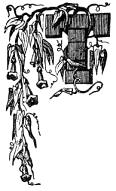 he
heroic Lady Ackland had listened to the thunder of the battle in which her
husband was engaged, and when, on the morning of the 8th, the British fell
back in confusion toward Wilbur's Basin, she, with the other women, was obliged
to take refuge among the dead and dying, for the tents were all struck, and
hardly a shed was left standing. Then she was informed that her husband was
wounded and a prisoner. She instantly sought the advice of her friend, the
Baroness Reidesel, and resolved to visit the American camp, and implore the
privilege of a personal attendance upon her husband. She sent a message by
Lord Petersham to Burgoyne, asking his permission to depart. The general was
astonished that, after all she had endured from exposure to cold, hunger,
and heavy rain, she should be capable of such an undertaking. "The assistance
I was enabled to give," he said, "was small indeed. I had not even
a cup of wine to offer her; but I was told she had found, from some kind and
fortunate hand, a little rum and dirty water. All I could furnish to her was
an open boat, and a few lines written upon dirty wet paper, to General Gates,
recommending her to his protection."*
he
heroic Lady Ackland had listened to the thunder of the battle in which her
husband was engaged, and when, on the morning of the 8th, the British fell
back in confusion toward Wilbur's Basin, she, with the other women, was obliged
to take refuge among the dead and dying, for the tents were all struck, and
hardly a shed was left standing. Then she was informed that her husband was
wounded and a prisoner. She instantly sought the advice of her friend, the
Baroness Reidesel, and resolved to visit the American camp, and implore the
privilege of a personal attendance upon her husband. She sent a message by
Lord Petersham to Burgoyne, asking his permission to depart. The general was
astonished that, after all she had endured from exposure to cold, hunger,
and heavy rain, she should be capable of such an undertaking. "The assistance
I was enabled to give," he said, "was small indeed. I had not even
a cup of wine to offer her; but I was told she had found, from some kind and
fortunate hand, a little rum and dirty water. All I could furnish to her was
an open boat, and a few lines written upon dirty wet paper, to General Gates,
recommending her to his protection."*
* The following is a copy of Burgoyne's note to Gates:--
SIR,--Lady Harriet Ackland, a lady of the first
distinction of family, rank, and person virtues, is under such concern on
account of Major Ackland, her husband, wounded and a prisoner in your hands,
that I cannot refuse her request to commit her to your protection. Whatever
general impropriety there may be in persons of my situation and yours to solicit
favours, I cannot see the uncommon perseverance in every female grace and
exaltation of character of this lady, and her very hard fortune, without testifying
that your attention to her will lay me under obligations.
I am, Sir, your obedient servant,
J. BURGOYNE
This note is preserved among Gates's manuscript papers, in the collection
of the New York Historical Society.
Lady Harriet set out in an open boat on the Hudson, accompanied
by Chaplain Brudenell, her waiting-maid, and her husband's valet, who had
been severely wounded while searching for his master on the battle-field.
They started at sunset, in the midst of a violent storm of wind and rain.
It was long after dark when they reached the American outposts, and there
they were detained, in a comfortable position, until orders should be received
from head-quarters. Early in the morning she received the joyful tidings that
her husband was safe. At the same time she was treated with paternal kindness
by General Gates, who sent her to her husband at Neilson's house, under a
suitable escort. She found him suffering, but well taken care of, in the portion
of the house occupied as
[Illustration : ROOM OCCUPIED BY MAJOR ACKLAND]
quarters by General Poor, and there she remained until Major Ackland was removed
to Albany, and finally to New York.,*
* Major Ackland died in November 1778. On her return to England, a portrait of Lady Harriet, standing in a boat, with a white handkerchief in her hand as a flag of truce, was exhibited at the Royal Academy (London), from which a plate was afterwards engraved. The person of her ladyship was spoken of as "highly graceful and delicate," and her manners "elegantly feminine."
From the house of Mr. Neilson, whose descendants now occupy
it, a fine view of the surrounding 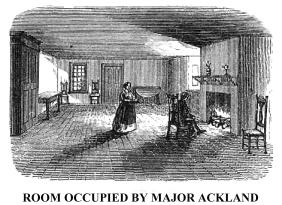 country
may be obtained. On the north and west, beginning at its very doors, lies
the entire battle-ground of the 19th of September; and bounding the horizon
in the distance beyond, are the Luzerne Mountains (already mentioned), through
which flow the waters of the Upper Hudson. On the east rise Willard's Mountain,
the heights of Bennington, the Green Mountains, and the famous Mount Tom;
and stretching away in the blue distances towards Albany, are seen the gentle
hills and beautiful valley of the Hudson. And there the visitor may see many
relics from the battle-field, turned up by the plough, such as cannon-balls,
bullets, Indian tomahawks and knives, rusty musket barrels, bayonets, halberds,
military buttons, pieces of money, et cetera.
country
may be obtained. On the north and west, beginning at its very doors, lies
the entire battle-ground of the 19th of September; and bounding the horizon
in the distance beyond, are the Luzerne Mountains (already mentioned), through
which flow the waters of the Upper Hudson. On the east rise Willard's Mountain,
the heights of Bennington, the Green Mountains, and the famous Mount Tom;
and stretching away in the blue distances towards Albany, are seen the gentle
hills and beautiful valley of the Hudson. And there the visitor may see many
relics from the battle-field, turned up by the plough, such as cannon-balls,
bullets, Indian tomahawks and knives, rusty musket barrels, bayonets, halberds,
military buttons, pieces of money, et cetera.
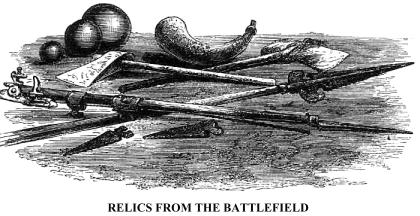 At
the foot of Bemis's Heights, where the old tavern of Bemis--famous for good
wines and long pipes, a spacious ball-room and a rich larder--once stood,
a pleasant hamlet has grown up. It is one of the numerous offsprings of the
canal. Two miles below it, at the head of long rapids, is Stillwater, the
most pleasing in situation and appearance of all the villages in the valley
of the Upper Hudson. It is otherwise remarkable only for a long, gloomy, and
unsightly covered toll-bridge, which, resting upon several huge piers, spans
the Hudson; and also as the head-quarters of the republican army, for a short
time, in the summer of 1777, after they had retreated down the valley before
victorious Burgoyne. The house of Derrick Swart, where General Schuyler had
his quarters at that time, was yet standing in the upper part of the village,
and awakened in the mind of the historical student recollections of a scene
that occurred there at a most gloomy period of the campaign. The army, wretchedly
furnished and daily diminishing, had retreated before an exultant foe; food,
clothing, and artillery were all wanting. The pecuniary resources and public
credit of the continental congress were failing, and all the future seemed
dark. At that moment intelligence came that Colonel St. Leger, who had been
sent up the St. Lawrence by Burgoyne, with instructions to cross Lake Ontario
to Oswego, penetrate the Mohawk valley from that point, form an alliance with
the Tories and Indians, and press forward to Albany with destructive energy,
had actually appeared before Fort Schuyler, where the village of Rome now
stands. The people of the Mohawk valley were wild with consternation, and
sent swift messengers to General Schuyler, imploring immediate assistance.
The prudent foresight and far-reaching humanity of that officer at once dictated
his course. He called a council of officers at his quarters, and proposed
sending a detachment immediately to the relief of Fort Schuyler.
At
the foot of Bemis's Heights, where the old tavern of Bemis--famous for good
wines and long pipes, a spacious ball-room and a rich larder--once stood,
a pleasant hamlet has grown up. It is one of the numerous offsprings of the
canal. Two miles below it, at the head of long rapids, is Stillwater, the
most pleasing in situation and appearance of all the villages in the valley
of the Upper Hudson. It is otherwise remarkable only for a long, gloomy, and
unsightly covered toll-bridge, which, resting upon several huge piers, spans
the Hudson; and also as the head-quarters of the republican army, for a short
time, in the summer of 1777, after they had retreated down the valley before
victorious Burgoyne. The house of Derrick Swart, where General Schuyler had
his quarters at that time, was yet standing in the upper part of the village,
and awakened in the mind of the historical student recollections of a scene
that occurred there at a most gloomy period of the campaign. The army, wretchedly
furnished and daily diminishing, had retreated before an exultant foe; food,
clothing, and artillery were all wanting. The pecuniary resources and public
credit of the continental congress were failing, and all the future seemed
dark. At that moment intelligence came that Colonel St. Leger, who had been
sent up the St. Lawrence by Burgoyne, with instructions to cross Lake Ontario
to Oswego, penetrate the Mohawk valley from that point, form an alliance with
the Tories and Indians, and press forward to Albany with destructive energy,
had actually appeared before Fort Schuyler, where the village of Rome now
stands. The people of the Mohawk valley were wild with consternation, and
sent swift messengers to General Schuyler, imploring immediate assistance.
The prudent foresight and far-reaching humanity of that officer at once dictated
his course. He called a council of officers at his quarters, and proposed
sending a detachment immediately to the relief of Fort Schuyler.
They opposed him with the argument that his whole force was
insufficient to stay the progress of 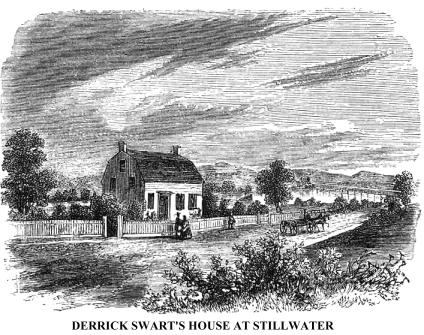 Burgoyne.
Schuyler persisted in his opinion, and earnestly besought them to second his
views. His political enemies had already sown the seeds of distrust concerning
his intentions; and as he was pacing the floor in anxious solicitude, he heard
from one of his subordinate officers the half-whispered remark, "He means
to weaken the army." Never was a thought more unjust and ungenerous!
Wheeling suddenly toward the slanderer and those around him, and unconsciously
biting into several pieces a pipe that he was smoking, Schuyler indignantly
exclaimed, "Gentlemen, I shall take the responsibility upon myself; where
is the brigadier that will take command of the relief? I shall beat up for
volunteers to-morrow."
Burgoyne.
Schuyler persisted in his opinion, and earnestly besought them to second his
views. His political enemies had already sown the seeds of distrust concerning
his intentions; and as he was pacing the floor in anxious solicitude, he heard
from one of his subordinate officers the half-whispered remark, "He means
to weaken the army." Never was a thought more unjust and ungenerous!
Wheeling suddenly toward the slanderer and those around him, and unconsciously
biting into several pieces a pipe that he was smoking, Schuyler indignantly
exclaimed, "Gentlemen, I shall take the responsibility upon myself; where
is the brigadier that will take command of the relief? I shall beat up for
volunteers to-morrow."
The brave and impulsive Arnold, who afterwards became a traitor, at once stepped forward. The next morning, when the drum beat for volunteers, no less than eight hundred strong men offered their services. They were enrolled; Fort Schuyler was saved, and the forces of St. Leger scattered to the winds. In after years the recollection of those burning words of calumny always stirred the spirit of the veteran patriot with violent emotions; for if ever a bosom glowed with true devotion to his country, it was that of Philip Schuyler.
From Stillwater to Troy at the head of free sloop navigation, a distance of about sixteen miles, the Hudson flows in a rapid stream, sometimes turbulent, but generally with a placid current. The valley, maintaining the same average width and general aspect, becomes richer in numerous farm-houses and more careful cultivation as we approach the cluster of large towns whose church spires may be seen soon after leaving Mechanicsville and Half-Moon, two pleasant little villages on the west bank of the Hudson. These are in the township of Half-Moon, so called in memory of Hendrick Hudson's famous yacht, in which he discovered the river that bears his name. They are a short distance below Stillwater. The Champlain Canal and the Rensselaer and Saratoga Railway pass through them. On the site of the latter village stood "ye fort of ye-Half-Moon, about ye house and barne of Harme Lievese"--a stockade for defence against the Indians. It was removed in the year 1689.
The summer drive upon the public road in this part of the valley is delightful. The plain and slopes have the appearance of a garden; while the hills on both sides present sweet pictures of mingled forest and cultivated fields, enlivened by small flocks and herds, and dotted with the homes of a thrifty people. But the river appears solitary. Not a boat may be seen upon it, until Waterford is passed, for the current is too swift for navigation. "The water in the river here," wrote Kalm, the Swedish naturalist and traveler, in his journal, more than one hundred years ago; "was very clear, and generally shallow, being only from two to four feet deep, running very violently against us in most places.
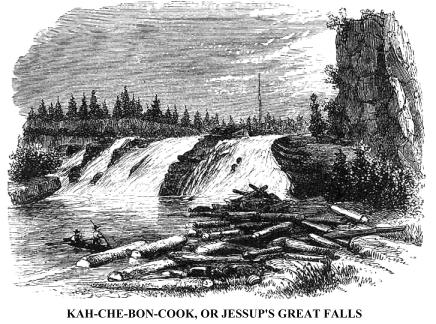 Between
Mechanicsville and Waterford, near the junction of two railways, the viaduct
of the Vermont Central Railroad, twelve hundred feet in length, stretches
across the Hudson. It is constructed of square timber, and rests upon heavy
stone piers, besides the shore abutments. From that point to Waterford, the
river views from the highway are very picturesque, and when within half a
mile of that large village upon Half-Moon Point, at a bend in the stream,
the traveler obtains a sight of Waterford and Lansingburgh, on opposite sides
of the river, with the covered toll-bridge that connects them. The church
spires of Troy are also seen, and in dim blue outline, in the extreme southern
horizon, appear the higher spurs of the Katzbergs, or Catskill Mountains.
Between
Mechanicsville and Waterford, near the junction of two railways, the viaduct
of the Vermont Central Railroad, twelve hundred feet in length, stretches
across the Hudson. It is constructed of square timber, and rests upon heavy
stone piers, besides the shore abutments. From that point to Waterford, the
river views from the highway are very picturesque, and when within half a
mile of that large village upon Half-Moon Point, at a bend in the stream,
the traveler obtains a sight of Waterford and Lansingburgh, on opposite sides
of the river, with the covered toll-bridge that connects them. The church
spires of Troy are also seen, and in dim blue outline, in the extreme southern
horizon, appear the higher spurs of the Katzbergs, or Catskill Mountains.
Waterford is a very pleasant town, at the confluence of the
Mohawk and Hudson rivers, and had then  a
little more than three thousand inhabitants. It stands upon the level bank
of the Hudson. Most of its streets are fringed with the maple and elm, the
favourite shade trees in the northern and eastern villages and cities of the
United States. It is a young town, compared with Lansingburgh, its still more
pleasant neighbour across the river, which was dignified with the title of
New City as early as 1788, when its now stately rival, Troy, could not boast
of half-a-dozen houses, and was known only as Vanderheyden, or Ashley's Ferry.
It has outstripped that older town in population, and equals it in enterprise.
Between them the current of the Hudson is strong, yet vessels laden with merchandise
ascend to the wharves of each, with the aid of small steam-tugs, which tow
them from the draw of the great bridge at Troy, two miles below.
a
little more than three thousand inhabitants. It stands upon the level bank
of the Hudson. Most of its streets are fringed with the maple and elm, the
favourite shade trees in the northern and eastern villages and cities of the
United States. It is a young town, compared with Lansingburgh, its still more
pleasant neighbour across the river, which was dignified with the title of
New City as early as 1788, when its now stately rival, Troy, could not boast
of half-a-dozen houses, and was known only as Vanderheyden, or Ashley's Ferry.
It has outstripped that older town in population, and equals it in enterprise.
Between them the current of the Hudson is strong, yet vessels laden with merchandise
ascend to the wharves of each, with the aid of small steam-tugs, which tow
them from the draw of the great bridge at Troy, two miles below.
At Waterford the ear catches the subdued roar of Cohoes Falls * in the Mohawk river, three-fourths of a mile distant. That stream is the largest tributary of the Hudson. It flows eastward, with a rapid current most of the way, from Oneida County; in the interior of the State of New York, through one of the richest agricultural regions in the world, for about one hundred and thirty-five miles, and enters the Hudson in four channels, formed by three islands, named respectively, Van Hover's, Van Schaick's, or Cohoes, and Green or Tibbett's Islands. Van Schaick's alone, which is almost inaccessible at many points, because of its high rocky shores, has escaped the transforming hand of improvement. There, in the summer of 1777, General Schuyler cast up some fortifications, with the determination to dispute with Burgoyne the passage of the Mohawk. Faint traces of those entrenchments may yet be seen; and, in the spring of 1860, a large zinc cartridge-box was found in that vicinity, supposed to have been left when General Schuyler moved northward. The banks of Van Schaick's are steep, a forest of evergreens clothes a large portion of its surface, and only a solitary barn indicates its cognizance by man.
* Cah-hoos, an Iroquois word, according to Brant, the great Mohawk chief, signifying a canoe falling.
Green Island, the larger of the three, stretches along the upper part of Troy, and is a theatre of industry for a busy population, engaged chiefly in manufactures, or in employments connected with railways. There was the immense establishment of Messrs. Eaton, Gilbert, & Co. (afterward destroyed by fire), the most extensive manufacturers of railway carriages, omnibuses, and stage coaches in the United States, if not in the world.
The scenery about the mouth of the Mohawk, particularly in the vicinity of Cohoes Falls, is exceedingly picturesque, and at some points really grand. A highway bridge, nine hundred feet in length, and a railway viaduct still longer, cross the river over the rapids a short distance below the falls. From the former, a fine distant view of the cataract and the rapids below may be obtained; but the best places to observe them in all their beauty and grandeur, are at and near the Cataract House, in the village of Cohoes, which stands upon the summit verge of a precipice one hundred and seventy feet in height. Down a steep slope of that precipice, for about fifty feet, the proprietor has constructed a flight of steps, and upon the top of a broad terrace at their foot he has planted a flower garden, for the enjoyment of visitors. Around its edge, from which may be obtained a view of the entire cataract, is a railing with seats, and there the visitor may contemplate at case the wild scene on every hand. On his left, as he gazes up the river, rush large streams of water from the top of the precipice above him, in almost perpendicular currents, from the waste-sluices of a canal, which, commencing at a dam almost two miles above the falls, conveys water to numerous mill-wheels in the village. By this means immense hydraulic power is obtained and distributed. *
* The water-power at Cohoes was under the control of a stock company, who rented it to the proprietors of mills and factories. the entire fall of water controlled by the company was one hundred and twenty feet; and the minimum supply of water was one thousand cubic feet each second. The estimated value of the various articles manufactured there at that time, was nearly three millions of dollars per annum.
Copyright © 1998, -- 2004. Berry Enterprises. All rights reserved. All items on the site are copyrighted. While we welcome you to use the information provided on this web site by copying it, or downloading it; this information is copyrighted and not to be reproduced for distribution, sale, or profit.